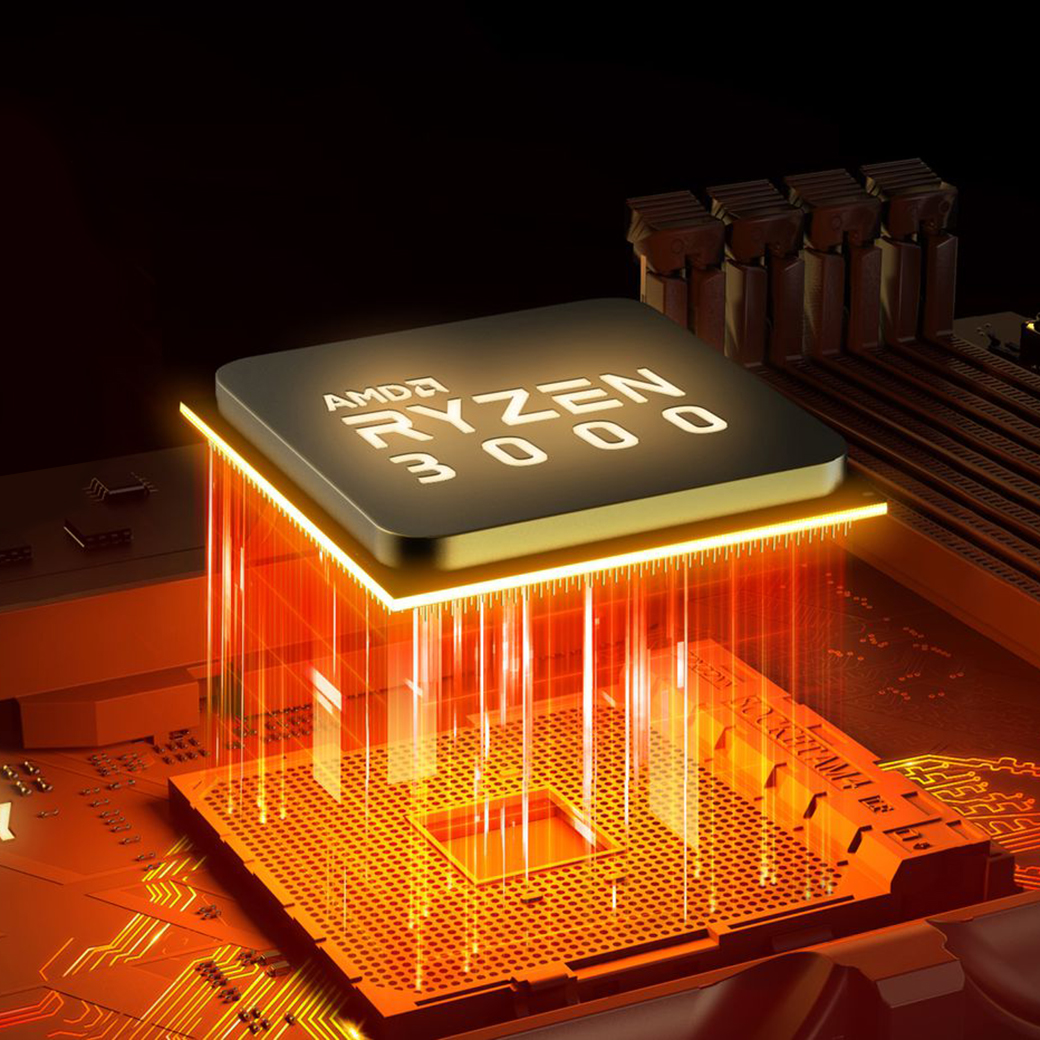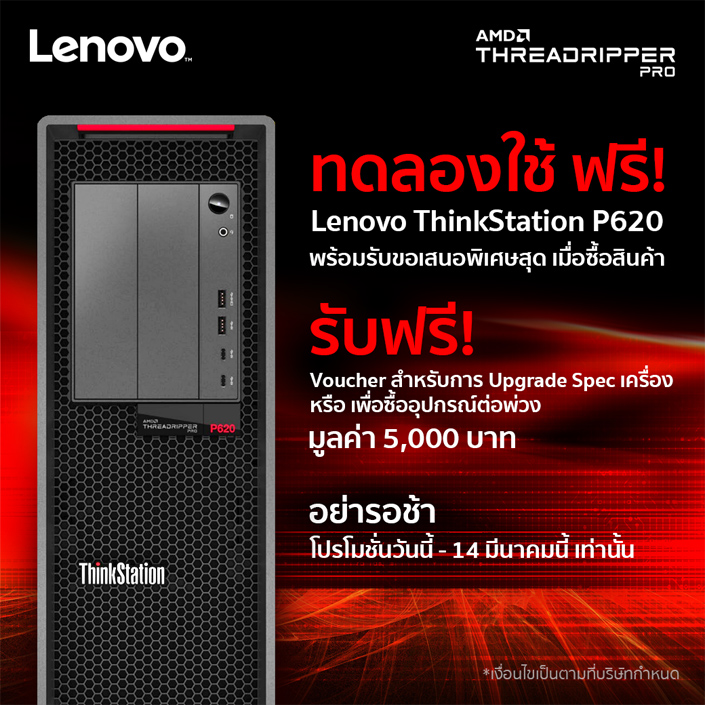AMD เปิดตัวโปรเซสเซอร์สถาปัตยกรรม “Zen” รุ่นแรกสำหรับ Chromebook ด้วยประสิทธิภาพที่รวดเร็วขึ้นในด้านการเข้าเว็บไซต์ การทำงาน และการทำงานรูปแบบมัลติทาสกิ้งที่ดียิ่งขึ้น

AMD เปิดตัวโปรเซสเซอร์สถาปัตยกรรม “Zen” รุ่นแรกสำหรับ Chromebook ด้วยประสิทธิภาพที่รวดเร็วขึ้นในด้านการเข้าเว็บไซต์ การทำงาน และการทำงานรูปแบบมัลติทาสกิ้งที่ดียิ่งขึ้น
– Acer, Asus, HP และ Lenovo พร้อมนำเสนอผลิตภัณฑ์ที่ครอบคลุมตั้งแต่ระดับเริ่มต้นไปจนถึงระดับพรีเมียม ด้วยการนำสถาปัตยกรรมประมวลผลที่ยอดเยี่ยม “Zen” เข้าตลาดกลุ่ม Chromebook –
กรุงเทพฯ, ประเทศไทย – 24 กันยายน 2563 – AMD (NASDAQ: AMD) เปิดตัว โปรเซสเซอร์ AMD Ryzen รุ่นแรก และโปรเซสเซอร์ AMD Athlon รุ่นล่าสุดสำหรับ แพลตฟอร์ม Chromebook มาพร้อมประสิทธิภาพในการเข้าเว็บไซต์ที่เร็วขึ้นถึง 178% เมื่อเทียบกับรุ่นก่อนหน้า[1] การออกแบบได้รับความร่วมมือกับ Google ทั้งนี้โปรเซสเซอร์ AMD Ryzen และ Athlon 3000 C-Series ขับเคลื่อนประสิทธิภาพการประมวลผลด้วยสถาปัตยกรรม “Zen” เป็นครั้งแรก ทำให้ประสิทธิภาพการทำงานรูปแบบมัลติทาสกิ้ง และการสร้างคอนเทนต์ดีขึ้นถึง 212% เมื่อนำไปเปรียบเทียบกับ AMD Chromebook รุ่นก่อนหน้า[2] พร้อมนำเสนอประสิทธิภาพ การประมวลผลด้านกราฟิกที่ยอดเยี่ยมที่สุด ด้วยกราฟิกการ์ด AMD Radeon™ Graphics[3]
ทั้งนี้ผลิตภัณฑ์ Chromebook ภายใต้แบรนด์ Acer, ASUS, HP และ Lenovo จะเปิดตัวในไตรมาสที่ 4 ของปี 2563
ซาอิด มาสคาลานี่ รองประธานอาวุโสและผู้จัดการทั่วไป ฝ่ายไคลเอนท์คอมพิวติ้ง บริษัท AMD กล่าวว่า “ผลิตภัณฑ์ Chromebook ที่ขับเคลื่อนประสิทธิภาพการประมวลผลด้วยโปรเซสเซอร์ AMD Ryzen และ Athlon นำเสนอการผสมผสานระหว่างประสิทธิภาพของโปรเซสเซอร์ และกราฟิกการ์ดได้อย่างลงตัว เพื่อการทำงานที่ยอดเยี่ยม และตอบสนองความต้องการของ ผู้ใช้งานทั้งด้านการเรียน และการทำงานทางไกล ทั้งในรูปแบบออนไลน์ ออฟไลน์ ระหว่างเดินทางหรือที่บ้าน เรารู้สึกยินดีที่ได้ร่วมงานกับ Acer, ASUS, Google, HP และ Lenovo เพื่อเพิ่มความหลากหลายสำหรับผลิตภัณฑ์ Chromebook ที่ใช้ประสิทธิภาพของโปรเซสเซอร์ AMD และส่งมอบตัวเลือกด้านประสิทธิภาพการทำงานที่มากขึ้นด้วยผลิตภัณฑ์ Chromebook ตัวแรกที่ใช้ AMD Ryzen”
โปรเซสเซอร์ AMD Ryzen และ Athlon 3000 C-Series
ผลิตภัณฑ์ Chromebook สร้างขึ้นบนสถาปัตยกรรม “Zen” อันทรงพลัง พร้อมกราฟิกการ์ด AMD Radeon ที่ยอดเยี่ยม มีความรวดเร็วและตอบสนองการใช้งานได้อย่างดีเยี่ยม ทั้งในด้านการเข้าเว็บไซต์ งานมัลติทาสกิ้ง หรือวีดีโอสตรีมมิ่ง โมบายโปรเซสเซอร์ 3000 C-Series ออกแบบมาให้ใช้พลังงานอย่างมีประสิทธิภาพ ทำให้การออกแบบผลิตภัณฑ์ Chromebook ได้ทั้งความบางและความเบาของผลิตภัณฑ์มากขึ้น พร้อมอายุการใช้งาน แบตเตอรี่ที่ยาวนาน ตลอดจนฟีเจอร์ Wi-Fi 6 และ Bluetooth 5 ที่ทำให้การต่อเชื่อม อินเทอร์เน็ตมีประสิทธิภาพดียิ่งขึ้น[4]
โปรเซสเซอร์ AMD Ryzen 7 3700C ในผลิตภัณฑ์ Chromebook นำเสนอประสิทธิภาพ ระดับพรีเมียม ประกอบด้วย:
- ประสิทธิภาพด้านกราฟิกที่ดีขึ้นถึง 251% เมื่อนำไปเทียบกับ AMD Chromebook รุ่นก่อนหน้า[5]
- ประสิทธิภาพการทำงานในสำนักงานที่รวดเร็วขึ้นถึง 104% เมื่อนำไปเทียบกับ AMD Chromebook รุ่นก่อนหน้า[6]
- ประสิทธิภาพการตัดต่อรูปภาพดีขึ้นถึง 152% เมื่อนำไปเทียบกับ AMD Chromebook รุ่นก่อนหน้า[7]
| MODEL | CORES / THREADS | TDP
(Watts) |
BOOST[viii]/BASE[ix] FREQ. (GHz) | GPU CORES | CACHE (MB) |
| AMD Ryzen™ 7 3700C | 4C/8T | 15W | Up to 4.0 / 2.3 GHz | 10 | 6 MB |
| AMD Ryzen™ 5 3500C | 4C/8T | 15W | Up to 3.7 / 2.1 GHz | 8 | 6 MB |
| AMD Ryzen™ 3 3250C | 2C/4T | 15W | Up to 3.5 / 2.6 GHz | 3 | 5 MB |
| AMD Athlon™ Gold 3150C | 2C/4T | 15W | Up to 3.3 / 2.4 GHz | 3 | 5 MB |
| AMD Athlon™ Silver 3050C | 2C/2T | 15W | Up to 3.2 / 2.3 GHz | 2 | 5 MB |
คำกล่าวสนับสนุน
โปรเซสเซอร์ AMD Ryzen และ Athlon 3000 C-Series จะวางจำหน่ายเร็ว ๆ นี้ ผ่านทางพันธมิตร OEM ในตลาดกลุ่มผู้บริโภค กลุ่มองค์กรการศึกษา และบริษัทฯ ต่างๆ
จอห์น โซโลมอน, Vice President of Chrome OS บริษัท Google กล่าวว่า “ผลิตภัณฑ์ Chromebook ยังคงเป็นกลุ่มตลาดที่เติบโตอย่างรวดเร็ว ลูกค้ามองหาผลิตภัณฑ์ ที่มีการออกแบบที่สวยงาม และมีฟีเจอร์การใช้งานที่ยอดเยี่ยม เพื่อทำให้ประสบการณ์ในการใช้งานเพื่อทำงาน เพื่อการศึกษา และเพื่อการเล่นเกมของพวกเขาผ่านระบบปฎิบัติการ Chrome OS ทรงพลังมากยิ่งขึ้น ความร่วมมือระหว่างเรากับ AMD ในการนำเสนอผลิตภัณฑ์ Chromebook ที่ขับเคลื่อนประสิทธิภาพด้วยโปรเซสเซอร AMD Ryzen ทำให้ผู้บริโภคและองค์กรธุรกิจต่าง ๆ มีทางเลือกในการตัดสินใจที่มากขึ้นทั้งในด้านราคาที่จับต้องได้ การเชื่อมต่ออินเทอร์เน็ตได้รวดเร็ว อายุการใช้งานแบตเตอรี่ที่ยาวนาน และความสามารถในการจัดการเวิร์คโหลดรูปแบบมัลติทาสกิ้งที่ยอดเยี่ยม”
เจมส์ ลิน, general manager, Notebooks, IT Products Business, บริษัท Acer Inc. กล่าวว่า “เรากำลังสานต่อความเป็นผู้นำและด้านนวัตกรรมในกลุ่มตลาดผลิตภัณฑ์ Chromebook ที่กำลังจะเปิดตัวในเร็วๆ นี้ ด้วยการนำโปรเซสเซอร์ AMD Ryzen และ Athlon 3000 C-Series มาขับเคลื่อนประสิทธิภาพด้านการประมวลผล เพื่อตอบสนองความต้องการ ของผู้บริโภคที่ต้องการใช้งานที่โรงเรียน ที่ทำงาน หรือที่บ้าน ผลิตภัณฑ์ Acer Chromebook รุ่นใหม่ของเราที่ใช้โปรเซสเซอร์ AMD จะเพิ่มประสิทธิภาพการทำงานทั้งด้านการประมวลผล กราฟิก การตอบสนองการทำงานและประสิทธิภาพที่เพิ่มขึ้น ช่วยให้ลูกค้ารับมือกับ โปรเจคที่ท้าทาย และใช้ประโยชน์จากแอปพลิเคชั่น และส่วนขยายภายในผลิตภัณฑ์ Chromebook ที่เพิ่มเข้ามาได้อย่างมีประสิทธิภาพ”
แอนดี้ โรดส์ global head of Commercial Personal Systems, HP Inc. กล่าวว่า “พนักงานในปัจจุบันต้องการอุปกรณ์การทำงานที่ใช้ระบบคลาวด์ได้อย่างมีประสิทธิภาพ มีความปลอดภัยสูง และใช้งานง่าย เพราะพวกเขาต้องปรับตัวให้เข้ากับรูปแบบการทำงานใหม่ ในปัจจุบันที่ต้องสามารถทำงานที่บ้านหรือที่สำนักงานก็ได้ เราภูมิใจในความร่วมมืออย่าง ต่อเนื่องระหว่าง HP กับ AMD เพื่อนำเสนอฟีเจอร์ด้านความปลอดภัยขั้นสูงเช่น Chrome Enterprise Security และฟีเจอร์ด้านการบริหารจัดการสำหรับผู้ใช้งานด้านธุรกิจ เพื่อปกป้องอุปกรณ์ปลายทางและผสานการจัดการด้านการทำงาน ผลิตภัณฑ์ใหม่ HP Pro c645 Chromebook ที่ขับเคลื่อนประสิทธิภาพด้วยโปรเซสเซอร์ AMD Ryzen รุ่นล่าสุด มาพร้อมขุมพลังที่ยอดเยี่ยม ระบบการรักษาความปลอดภัย และการจัดการในระดับองค์กร และเครื่องมือในการทำงานร่วมกันอย่างไร้รอยต่อ เพื่อตอบสนองความต้องการด้านการทำงาน ของผู้ใช้ได้ทุกที่ทุกเวลา”
เจอร์รี่ พาราไดซ์ vice president, commercial portfolio, PC & Smart Devices บริษัท Lenovo กล่าวว่า “ผลิตภัณฑ์ Lenovo ที่ขับเคลื่อนประสิทธิภาพด้วยโปรเซสเซอร์ AMD ออกแบบมาเพื่อตอบสนองความต้องการกลุ่มผู้ใช้แล็บท็อป ที่ต้องการสมดุลด้านประสิทธิภาพ การใช้งาน ด้วยจุดเด่นด้านการพกพา ทำให้ผู้ใช้สามารถทำงานได้จากระยะไกล หรือแม้ขณะเดินทาง การเป็นพันธมิตรกับ AMD ทำให้เราสามารถส่งมอบ ประสบการณ์การใช้งานที่รวดเร็ว และตอบสนองความต้องการให้กับลูกค้า ผ่านผลิตภัณฑ์แล็ปท็อปที่ทรงพลังและพกพาสะดวก”
Supporting Resources
- Learn more about Ryzen 3000 C-Series and Athlon 3000 C-Series in the consumer space
- Learn more about Ryzen 3000 C-Series and Athlon 3000 C-Series in the commercial space
- Become a fan of AMD on Facebook
- Follow AMD on Twitter
เกี่ยวกับ AMD
เป็นเวลากว่า 50 ปีที่ AMD ขับเคลื่อนให้เกิดนวัตกรรมที่มีประสิทธิภาพสูงทั้งในส่วนของการประมวลผลกราฟิก และเทคโนโลยีเวอร์ชวลไลเซชั่นต่าง ๆ ซึ่งเป็นส่วนสำคัญสำหรับวงการเกม เป็นแพลตฟอร์มระดับมืออาชีพ และเป็นศูนย์กลางข้อมูล ผู้บริโภคหลายร้อยล้านคน องค์กรธุรกิจชั้นนำที่จัดอยู่ในกลุ่ม Fortune 500 และหน่วยงานวิจัยทางวิทยาศาสตร์สมัยใหม่ทั่วโลก ต่างใช้เทคโนโลยีของ AMD เพื่อการพัฒนาศักยภาพด้านต่าง ๆ ไม่ว่าจะเป็น การใช้ชีวิต การทำงาน และความบันเทิง พนักงานของ AMD ทุกคนทั่วโลกล้วนมุ่งพัฒนาผลิตภัณฑ์ใหม่ ๆ ที่จะก้าวข้ามขอบเขตของข้อจำกัดทั้งหลาย ท่านสามารถดูข้อมูลเพิ่มเติมเกี่ยวกับ AMD (NASDAQ: AMD) และกระบวนการสร้างสรรค์ต่าง ๆ ที่เราทำในปัจจุบันและที่กำลังจะเกิดขึ้นในอนาคตได้ที่เว็บไซต์ website, blog, Facebook และ Twitter
Cautionary Statement
This document contains forward-looking statements concerning Advanced Micro Devices, Inc. (AMD) such as the features, functionality, performance, availability, timing and expected benefits of AMD Ryzen™ and AMD Athlon™ mobile processors for Chromebook platforms, which are made pursuant to the Safe Harbor provisions of the Private Securities Litigation Reform Act of 1995. Forward looking statements are commonly identified by words such as “would,” “may,” “expects,” “believes,” “plans,” “intends,” “projects” and other terms with similar meaning. Investors are cautioned that the forward-looking statements in this press release are based on current beliefs, assumptions and expectations, speak only as of the date of this press release and involve risks and uncertainties that could cause actual results to differ materially from current expectations. Such statements are subject to certain known and unknown risks and uncertainties, many of which are difficult to predict and generally beyond AMD’s control, that could cause actual results and other future events to differ materially from those expressed in, or implied or projected by, the forward-looking information and statements. Material factors that could cause actual results to differ materially from current expectations include, without limitation, the following: Intel Corporation’s dominance of the microprocessor market and its aggressive business practices; the ability of third party manufacturers to manufacture AMD’s products on a timely basis in sufficient quantities and using competitive technologies; expected manufacturing yields for AMD’s products; AMD’s ability to introduce products on a timely basis with features and performance levels that provide value to its customers; global economic uncertainty; the loss of a significant customer; AMD’s ability to generate revenue from its semi-custom SoC products; the impact of the COVID-19 pandemic on AMD’s business, financial condition and results of operations; political, legal, economic risks and natural disasters; the impact of government actions and regulations such as export administration regulations, tariffs and trade protection measures; potential security vulnerabilities; potential IT outages, data loss, data breaches and cyber-attacks; uncertainties involving the ordering and shipment of AMD’s products; quarterly and seasonal sales patterns; the restrictions imposed by agreements governing AMD’s notes and the secured credit facility; the competitive markets in which AMD’s products are sold; AMD’s ability to generate sufficient revenue and operating cash flow or obtain external financing for research and development or other strategic investments; the potential dilutive effect if the 2.125% Convertible Senior Notes due 2026 are converted; market conditions of the industries in which AMD products are sold; AMD’s reliance on third-party intellectual property to design and introduce new products in a timely manner; AMD’s reliance on third-party companies for the design, manufacture and supply of motherboards, software and other computer platform components; AMD’s reliance on Microsoft Corporation and other software vendors’ support to design and develop software to run on AMD’s products; AMD’s reliance on third-party distributors and add-in-board partners; future impairments of goodwill and technology license purchases; AMD’s ability to attract and retain qualified personnel; AMD’s indebtedness; AMD’s ability to generate sufficient cash to service its debt obligations or meet its working capital requirements; AMD’s ability to repurchase its outstanding debt in the event of a change of control; the cyclical nature of the semiconductor industry; the impact of acquisitions, joint ventures and/or investments on AMD’s business; the impact of modification or interruption of AMD’s internal business processes and information systems; the availability of essential equipment, materials or manufacturing processes; compatibility of AMD’s products with some or all industry-standard software and hardware; costs related to defective products; the efficiency of AMD’s supply chain; AMD’s ability to rely on third party supply-chain logistics functions; AMD’s stock price volatility; worldwide political conditions; unfavorable currency exchange rate fluctuations; AMD’s ability to effectively control the sales of its products on the gray market; AMD’s ability to adequately protect its technology or other intellectual property; current and future claims and litigation; potential tax liabilities; and the impact of environmental laws, conflict minerals-related provisions and other laws or regulations. Investors are urged to review in detail the risks and uncertainties in AMD’s Securities and Exchange Commission filings, including but not limited to AMD’s Quarterly Report on Form 10-Q for the quarter ended June 27, 2020.
[1] Testing by AMD Performance Labs as of 09/01/2020. Chromebook manufacturers may vary configurations yielding different results. Performance may vary. RC-08
[2] Testing by AMD Performance Labs as of 04/22/2020 utilizing a Ryzen 7 3700C and a similarly configured system with AMD A6-9220C processor in the following benchmarks: Geek Bench 4 Multicore. PC manufacturers may vary configurations yielding different results. Performance may vary. RC-04
[3] Testing by AMD Performance Labs as of 04/22/2020 utilizing a Ryzen 7 3700C processor vs. An Acer Chromebook Spin 13 with an Intel Core i7-8550U, an Acer Chromebook Spin 713 with an Intel Core i5-10210U, and a Lenovo Chromebook with a Core i3-10110U in the following benchmark: 3DMark Sling Shot Score. Chromebook manufacturers may vary configurations yielding different results. Performance may vary. 3DMark is a trademark of Futuremark Corporation. RC-14
[4] Wi-Fi 6 and Bluetooth 5.0 availability varies by laptop manufacturer and are system configuration dependent. Check with your laptop manufacturer for compatibility information. GD-149.
[5] Testing by AMD Performance Labs as of 09/01/2020 on a Ryzen 7 3700C CPU vs. an AMD A6-9220C CPU using the 3DMark Sling Shot Extreme Open GL benchmark. Chromebook manufacturers may vary configurations yielding different results. Performance may vary. 3DMark is a Trademark of Futuremark Corporation. RC-07
[6] Testing by AMD Performance Labs as of 09/01/2020 utilizing the following benchmark: PCMark Writing 2.0 Score. Chromebook manufacturers may vary configurations yielding different results. Performance may vary. PCMark is a trademark of Futuremark Corporation. RC-11
[7] Testing by AMD Performance Labs as of 09/01/2020 utilizing the following benchmark: PCMark photo editing. Chromebook manufacturers may vary configurations yielding different results. Performance may vary. PCMark is a trademark of Futuremark Corporation. RC-10
[viii] Max boost for AMD Ryzen Processors is the maximum frequency achievable by a single core on the processor running a bursty single-threaded workload. Max boost will vary based on several factors, including, but not limited to: thermal paste; system cooling; motherboard design and BIOS; the latest AMD chipset driver; and the latest OS updates. GD-150
[ix] Base frequency is the approximate processor clock speed of a typical workload running at the processor’s standard TDP. GD-166.









